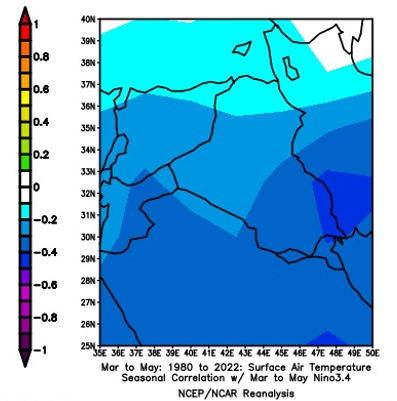The Telecommunications between Iraq Region Air Temperature and ENSO El NIÑO 3.4 Region
DOI:
https://doi.org/10.23851/mjs.v36i1.1558Keywords:
ENSO, Minimum temperature, Maximum temperature, Relative humidity, Sea surface temperature anomaliesAbstract
Background: El NIÑO phenomenon is a global climate phenomenon that occurs as a result of the interaction between the surface of the Pacific Ocean and the atmosphere directly above it. Objective: This study investigates whether El NIÑO 3.4 affects some of the climatic parameters in some Iraqi cities. Methods: A record surface data (2007-2017) of relative humidity, maximum and minimum air temperature was used from the Iraqi meteorological and seismology organization for seven selected meteorological stations, sea surface temperature anomalies from the royal Netherlands meteorological institute, and the reanalysis data of air temperature (1980-2022) from the national centers for environmental prediction and national center for atmospheric research. The climatic parameters data for seasonal and mean monthly are analyzed to understand the general trend, and the statistical relationships are investigated. Results: The result shows a decrease in relative humidity for Kirkuk and Nasiriya stations. Also, there is an increase in the general trend of the maximum and minimum temperatures for Kirkuk, Nasiriya, Basra, Baghdad, Al-Hay, and Mosul stations. The influence of the NIÑO 3.4 index on Iraq's climate, temperature, and relative humidity was minimal. The impact of the NIÑO 3.4 index on the maximum and minimum temperatures within the daily and monthly values, in general, was a weak positive correlation. The correlation between the NIÑO 3.4 index and the maximum and minimum temperatures during the spring and winter seasons is positive, while it is a negative correlation in the summer and autumn seasons. Conclusions: The main conclusion illustrated that the effect of the NIÑO 3.4 has a limited impact on the surface values of relative humidity and maximum and minimum air temperatures because there is a lag time in the response when the change of sea surface temperature anomalies starts to happen; it takes a month or more time until its impacts reach Iraq.
Downloads
References
X. L. Yu and S. R. Zhang, "Non-Linear pattern analysis of El Niño's impact on tropical precipitation," vol. 96, EDP Sciences, May 2019, p. 03 001.
CrossRef
W. Cai, S. Borlace, M. Lengaigne, P. van Rensch, M. Collins, G. Vecchi, A. Timmermann, A. Santoso, M. J. McPhaden, L. Wu, M. H. England, G. Wang, E. Guilyardi, and F.-F. Jin, "Increasing frequency of extreme El Niño events due to greenhouse warming," Nature Climate Change, vol. 4, no. 2, pp. 111–116, 2014.
CrossRef
M. G. Donat, T. C. Peterson, M. Brunet, A. D. King, M. Almazroui, R. K. Kolli, D. Boucherf, A. Y. Al‐Mulla, A. Y. Nour, A. A. Aly, T. A. A. Nada, M. M. Semawi, H. A. Al Dashti, T. G. Salhab, K. I. El Fadli, M. K. Muftah, S. Dah Eida, W. Badi, F. Driouech, K. El Rhaz, M. J. Y. Abubaker, A. S. Ghulam, A. S. Erayah, M. B. Mansour, W. O. Alabdouli, J. S. Al Dhanhani, and M. N. Al Shekaili, "Changes in extreme temperature and precipitation in the Arab region: long-term trends and variability related to ENSO and NAO," International Journal of Climatology, vol. 34, no. 3, pp. 581–592, 2014.
CrossRef
S. Curtis and D. H. Douglass, "Phase-locked tropical Pacific precipitation," Atmospheric Science Letters, vol. 17, no. 2, pp. 169–176, 2016.
CrossRef
S. Yang, Z. Li, J.-Y. Yu, X. Hu, W. Dong, and S. He, "El Niño-Southern Oscillation and its impact in the changing climate," National Science Review, vol. 5, no. 6, pp. 840–857, 2018.
CrossRef
A. Santoso, M. J. McPhaden, and W. Cai, "The defining characteristics of ENSO extremes and the strong 2015/2016 El Niño," Reviews of Geophysics, vol. 55, no. 4, pp. 1079–1129, 2017.
CrossRef
D. M. Zermeño Díaz and L. G. Mendoza, "The influence of ENSO during spring over northwestern Mexico," International Journal of Climatology, vol. 43, no. 14, pp. 6420–6433, 2023.
CrossRef
R. Shunmugapandi, S. Gedam, and A. B. Inamdar, "Impact of 2015–2016 El Niño on phytoplankton size class distribution during the summer and winter monsoon in the Arabian Sea," International Journal of Remote Sensing, vol. 45, no. 23, pp. 9017–9032, Dec. 2023.
CrossRef
P. M. Cox, R. A. Betts, M. Collins, P. P. Harris, C. Huntingford, and C. D. Jones, "Amazonian forest dieback under climate-carbon cycle projections for the 21st century," Theoretical and Applied Climatology, vol. 78, no. 1–3, pp. 137–156, 2004.
CrossRef
J. Zhu, A. Kumar, W. Wang, Z.-Z. Hu, B. Huang, and M. A. Balmaseda, "Importance of convective parameterization in ENSO predictions," Geophysical Research Letters, vol. 44, no. 12, pp. 6334–6342, 2017.
CrossRef
J. Blunden and D. S. Arndt, "State of the climate in 2015," Bulletin of the American Meteorological Society, vol. 97, no. 8, pp. Si–S275, 2016.
CrossRef
X. Zou, L. Yan, J. Xu, and S. Zheng, "The impacts of regime shift in summer arctic oscillation on precipitation in East Asia," Atmosphere, vol. 15, no. 3, p. 283, 2024.
CrossRef
J. Helali, H. Momenzadeh, S. Salimi, S. A. Hosseini, M. Lotfi, S. M. Mohamadi, G. M. Moghim, F. Pazhoh, and M. Ahmadi, "Synoptic-dynamic analysis of precipitation anomalies over Iran in different phases of ENSO," Arabian Journal of Geosciences, vol. 14, no. 22, p. 2322, 2021.
CrossRef
J.-Y. Lin, M.-C. Tang, and F. Wijaya, "Satellite oceanographic data processing and analysis: Correlation between Nino 3.4 sea surface temperature & sea Surface high and wind," Indonesian Journal of Earth Sciences, vol. 2, no. 2, pp. 157–176, 2022.
CrossRef
H. Gong, L. Wang, and W. Chen, "Multidecadal changes in the influence of the arctic oscillation on the East Asian surface air temperature in boreal winter," Atmosphere, vol. 10, no. 12, p. 757, 2019.
CrossRef
Z. M. Mie Sein, I. Ullah, S. Syed, X. Zhi, K. Azam, and G. Rasool, "Interannual variability of air temperature over Myanmar: The influence of ENSO and IOD," Climate, vol. 9, no. 2, p. 35, 2021.
CrossRef
J. Eggeling, C. Gao, D. An, R. Cruz-Cano, H. He, L. Zhang, Y.-C. Wang, and A. Sapkota, "Spatiotemporal link between El Niño Southern Oscillation (ENSO), extreme heat, and thermal stress in the Asia-Pacific region," Scientific Reports, vol. 14, no. 1, p. 7448, 2024.
CrossRef | PubMed
C. Varotsos, N. V. Sarlis, Y. Mazei, D. Saldaev, and M. Efstathiou, "A composite tool for forecasting El Niño: The case of the 2023–2024 Event," Forecasting, vol. 6, no. 1, pp. 187–203, 2024.
CrossRef
A. G. Mutar, A. Khtan, and L. E. George, "Synoptic characteristics of torrential rains in southwest and southeast Iraq: A case study," Al-Mustansiriyah Journal of Science, vol. 32, no. 3, pp. 1–7, 2021.
CrossRef
M. A. R. Jabbar and A. S. Hassan, "The daily pattern at 500 hPa geopotential heights and its association with heavy rainfall over Iraq," Iraqi Journal of Science, vol. 64, no. 3, pp. 1498–1507, 2023.
CrossRef
L. Azeez, "Demonstration of net solar radiation geographical behavior revers correlation with relative humidity in Iraq," Iraqi Journal of Science, vol. 63, no. 6, pp. 2741–2754, 2022.
CrossRef
M. A. Al-Tameemi, B. J. Hassan, and A. G. Mutar, "The effect of solar activity on stratospheric temperature over Iraq for period 1948–2014," Al-Mustansiriyah Journal of Science, vol. 33, no. 2, pp. 8–13, 2022.
CrossRef
A. G. Mutar, A. Khtan, and L. E. George, "Effect of sea salt AOT on precipitation processes associated with red sea moisture flux on Iraq, a case study," Al-Mustansiriyah Journal of Science, vol. 33, no. 2, pp. 1–7, 2022.
CrossRef
A. R. Al-Nassar, J. L. Pelegrí, P. Sangrà, M. Alarcon, and A. Jansa, "Cut-off low systems over Iraq: Contribution to annual precipitation and synoptic analysis of extreme events," International Journal of Climatology, vol. 40, no. 2, pp. 908–926, 2019.
CrossRef
S. M. Awadh, "Impact of North African sand and dust storms on the Middle East using Iraq as an example: Causes, sources, and mitigation," Atmosphere, vol. 14, no. 1, p. 180, 2023.
CrossRef

Downloads
Key Dates
Received
Revised
Accepted
Published
Data Availability Statement
1. Daily recorded dataset from the Iraqi Meteorological and Seismology Organization (private data).
2. Monthly data of El NIÑO 3.4 by the Royal Netherlands Meteorological Institute: https://climexp.knmi.nl/start.cgi
3. Atmospheric research NCAR (air temperature from 1980-2022) the national centers for environmental prediction (NCEP) and the national center: https://psl.noaa.gov/data/gridded/data.ncep.reanalysis.html
Issue
Section
License
Copyright (c) 2025 Muthanna A. Al-Tameemi, Ali Raheem Al-Nassar, Aqeel Ghazi Mutar, Arjuna Castrillon

This work is licensed under a Creative Commons Attribution 4.0 International License.
(Starting May 5, 2024) Authors retain copyright and grant the journal right of first publication with the work simultaneously licensed under a Creative Commons Attribution (CC-BY) 4.0 License that allows others to share the work with an acknowledgement of the work’s authorship and initial publication in this journal.





















